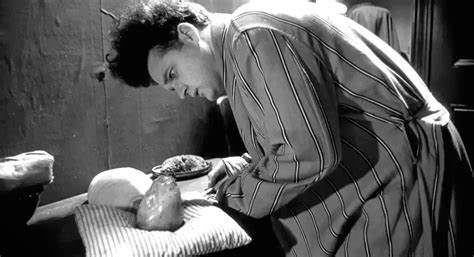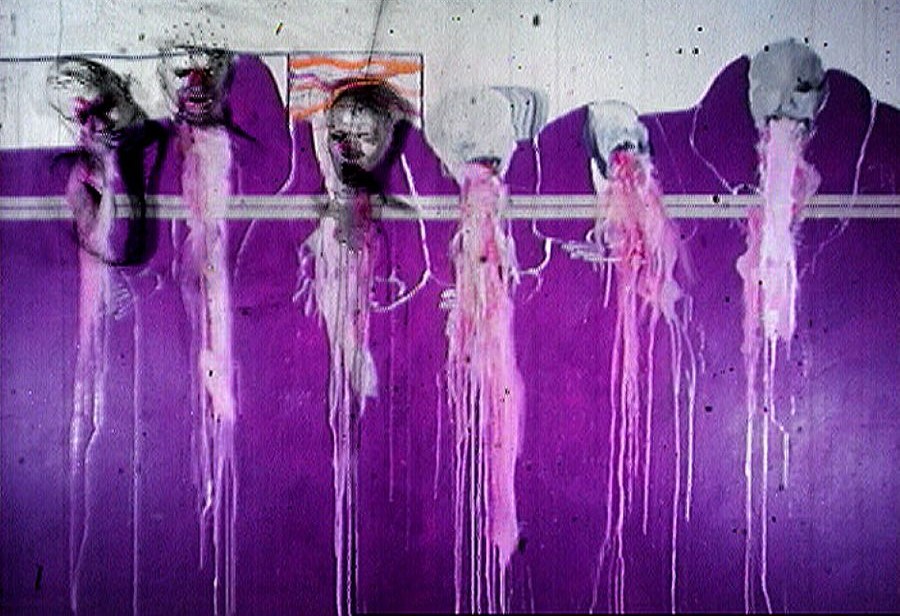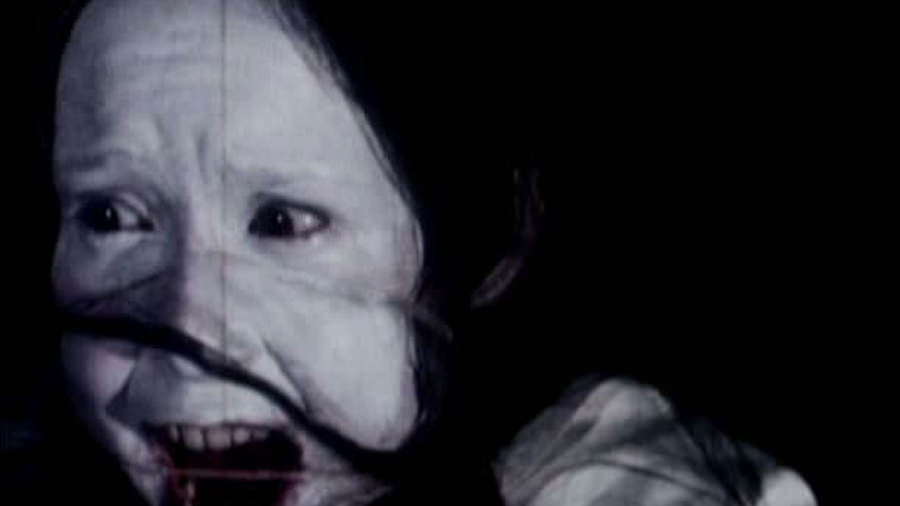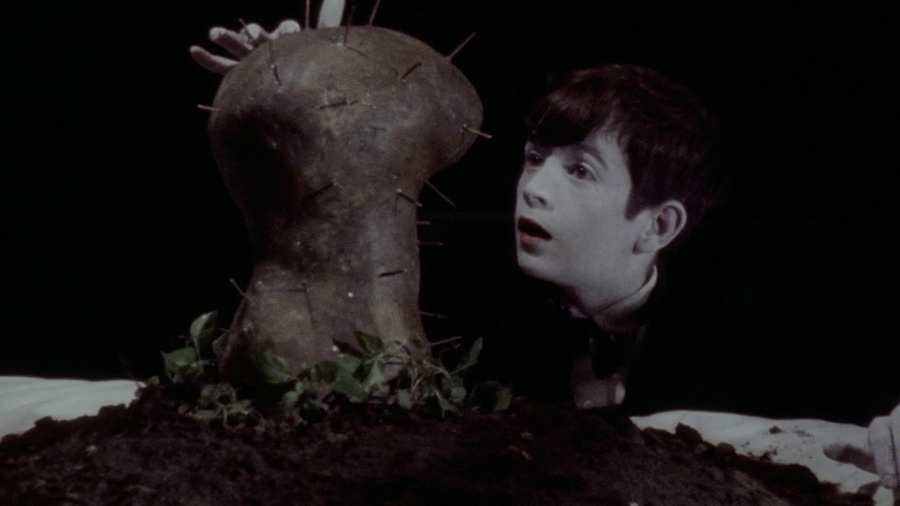The Early Short Films of David Lynch
Like many film goers, Eraserhead (1977), perpetually on the midnight screening circuit in the ’80s, was my first introduction to the works of David Lynch. And perhaps like some others, I was struck at the time how prescient the visual look of the film was. Although Eraserhead had taken over six years to make, its visual and aural aesthetic, the jagged angles, B&W cinematography, depressing black comedy tone and even Jack Nance’s crazy, proto-punk hairdo, all looked ahead to the late ’70s and early ’80s, with its Gothic music movements utilizing German Expressionist film imagery.  Bauhaus’s “Bela Lugosi’s Dead” 12″, for example, used a still from Robert Wiene’s 1920 The Cabinet of Dr. Caligari, and Lynch was clearly indebted to German Expressionism and Surrealism. The look of Eraserhead even reminded me of the German Expressionist-influenced group Split Enz, in far-flung New Zealand, who were dressing similarly in 1975. I chalked these connections up to different artists tapping into the zeitgeist — until I saw Lynch’s earliest work. Now I wonder if his ’60s and early ’70s output wasn’t an underground influence on these later manifestations.
Bauhaus’s “Bela Lugosi’s Dead” 12″, for example, used a still from Robert Wiene’s 1920 The Cabinet of Dr. Caligari, and Lynch was clearly indebted to German Expressionism and Surrealism. The look of Eraserhead even reminded me of the German Expressionist-influenced group Split Enz, in far-flung New Zealand, who were dressing similarly in 1975. I chalked these connections up to different artists tapping into the zeitgeist — until I saw Lynch’s earliest work. Now I wonder if his ’60s and early ’70s output wasn’t an underground influence on these later manifestations.
 David Lynch has, since the beginning of his career, been a painter and sculptor, though one who was inspired to make films after wanting to see his paintings move. His “Six Men Getting Sick (Six Times)”, 1967, is a combination of sculpture, sound and animation which foretells much of his subsequent preoccupations. A looping siren sound sets a dreaded tone for nausea relieved only by vomiting; at one point fire darts in front of the screen, a motif used as recently as Lynch’s 1995 “Premonition Following an Evil Deed” (using the Lumiere Brothers’ 1890s camera). “Unsettling” is the best description of this first work (and nearly everything Lynch has made afterwards).
David Lynch has, since the beginning of his career, been a painter and sculptor, though one who was inspired to make films after wanting to see his paintings move. His “Six Men Getting Sick (Six Times)”, 1967, is a combination of sculpture, sound and animation which foretells much of his subsequent preoccupations. A looping siren sound sets a dreaded tone for nausea relieved only by vomiting; at one point fire darts in front of the screen, a motif used as recently as Lynch’s 1995 “Premonition Following an Evil Deed” (using the Lumiere Brothers’ 1890s camera). “Unsettling” is the best description of this first work (and nearly everything Lynch has made afterwards).
 “The Alphabet” (1968) is a true revelation. It’s another mixture of painting, animation and sculpture, expressing a young girl’s nightmare. The look of its live action sequence, with a Kabuki-painted young girl against a Francis Baconesque black background, gives nothing away from the late ’60s; you’d swear it was brought forth from a late ’70s gothic primordial stew. “The Alphabet” also includes the grating cry of a baby (looking forward to Eraserhead) and, as with most of Lynch’s work, features organic forms driving up from the earth or transforming, a fascination with the process of organic growth and decay which dates back to his earliest memories as the son of a research scientist working for the U.S. Department of Agriculture. The film’s visual aesthetic is uncannily ahead of its time.
“The Alphabet” (1968) is a true revelation. It’s another mixture of painting, animation and sculpture, expressing a young girl’s nightmare. The look of its live action sequence, with a Kabuki-painted young girl against a Francis Baconesque black background, gives nothing away from the late ’60s; you’d swear it was brought forth from a late ’70s gothic primordial stew. “The Alphabet” also includes the grating cry of a baby (looking forward to Eraserhead) and, as with most of Lynch’s work, features organic forms driving up from the earth or transforming, a fascination with the process of organic growth and decay which dates back to his earliest memories as the son of a research scientist working for the U.S. Department of Agriculture. The film’s visual aesthetic is uncannily ahead of its time.
 The American Film Institute gave Lynch grants to create his next two films, “The Grandmother” and Eraserhead. “The Grandmother” (1970) starts with the protagonist’s parents shooting up from the earth, fully formed, though initially doglike. The only word Father and Mother can muster is to shout at their Son “Mutt!”. The Father looks like the later big-haired Robert Smith, of The Cure. The Son, in an effort to escape physical and mental abuse from his parents, grows a loving Grandmother from dirt and seeds in an upstairs bedroom.
The American Film Institute gave Lynch grants to create his next two films, “The Grandmother” and Eraserhead. “The Grandmother” (1970) starts with the protagonist’s parents shooting up from the earth, fully formed, though initially doglike. The only word Father and Mother can muster is to shout at their Son “Mutt!”. The Father looks like the later big-haired Robert Smith, of The Cure. The Son, in an effort to escape physical and mental abuse from his parents, grows a loving Grandmother from dirt and seeds in an upstairs bedroom.
“The Grandmother” was Lynch’s first collaboration with sound designer Alan Splet, and the rumbling, almost subconscious, sound of impending doom often heard in Lynch’s films was first used here. Also first used are Lynch’s prototypical trashy, low-class bullies, with empty beer bottles scattered upright — Lynch was still using the same motif in his “Crazy Clown Time” music video (2011).
 It’s remarkable how consistent Lynch’s artistic vision has been over the course of 50 years. His music videos for Nine Inch Nails’ Come Back Haunted (2013) and Interpol’s I Touch A Red Button Man (2011) utilize the same creepy mixture of painting, sculpture, animation and sound as used in the early films discussed here.
It’s remarkable how consistent Lynch’s artistic vision has been over the course of 50 years. His music videos for Nine Inch Nails’ Come Back Haunted (2013) and Interpol’s I Touch A Red Button Man (2011) utilize the same creepy mixture of painting, sculpture, animation and sound as used in the early films discussed here.
The Short Films of David Lynch DVD features “Six Men Getting Sick (Six Times)”, “The Alphabet”, “The Grandmother”, “The Amputee”, “The Cowboy and the Frenchman” and “Premonition Following an Evil Deed”, each introduced by Lynch (and purposely programmed to be impossible to forward through).
—Michael R. Neno, 2018 March 14